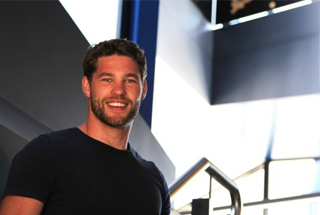Bridging the gap between learning and memory

To help scientists better understand processes behind learning and memory, ANU PhD student Jason Whitfield has developed a new tool to track communication between cells within the brain.
Inspired by finding out what happens when our brain tries to learn something, Jason, along with Dr Colin Jackson from ANU and collaborators at the University of Bonn in Germany, developed a special kind of tool, called a biosensor.
This new biosensor can give scientists a visual picture of where chemicals are being used in the brain and is the latest addition to a rapidly growing field.
“The idea started with learning and memory,” he explains. “When you are learning, your brain cells communicate by releasing signals called neurotransmitters. If you use these signals more they grow in strength and the synapses between these cells become more receptive.
“That is how you become proficient at learning a skill. You’re using these molecular highways more and they become stronger. We don’t know really what happens in molecular detail. We know there are key neurotransmitters involved, but we can’t really study their dynamic nature.”
This is where Jason’s biosensor comes in.
“This biosensor process can be thought of as like a Venus fly trap. The fly in this instance would be a neurotransmitter. The idea is that these biosensors can emit a signal by closing like a Venus fly trap when they interact with a neurotransmitter.
“You can track the biosensors with fluorescent proteins, so with the release of a neurotransmitter, you can see in the brain where the neurotransmitter is actually affecting it and you can start to understand these learning pathways.”
As a chemist at the ANU Research School of Chemistry, Jason was particularly interested in the amino acid arginine, the only known molecule that is used to make Nitric oxide, which plays a vital role in several bodily systems.
“Nitric Oxide is a very potent secondary messenger for things like widening your blood stream – also known as vasodilation – and they know it has a role in memory formation. So there is a school of thought that a breakdown in arginine signalling could be an indicator for things like Alzheimer’s.”
Alzheimer’s is a form of dementia characterised by a gradual degradation in a person’s memory. The links between Alzheimer’s and learning and memory are not clear, however a characteristic early symptom of the disease is difficulty in remembering recently learned information.
To track the distribution of molecules like arginine in brain tissue, scientists have developed many biosensors. Jason has done the same thing, except his biosensors work even better.
“People have made sensors for arginine before, and they are fine to make measurements at room temperature but not all of them are stable enough in relevant body conditions.
“That’s where in part ours improves. We are actually able to do it at a biological temperature. So you could say that the data is more meaningful because it’s done in conditions which reflect the biological system.”
Jason hopes that his research can help others examine the role of arginine in disorders like Alzheimer’s, something that many neuroscientists are currently investigating.
“It would be cool if people could use these sensors to try and find different levels of arginine that could be associated in a disease state. That what this project is centred around, generating tools for people to use.”
The research was published in Protein Science, a video abstract is also available.
https://science.anu.edu.au/news-events/news/bridging-gap-between-learning-and-memory
